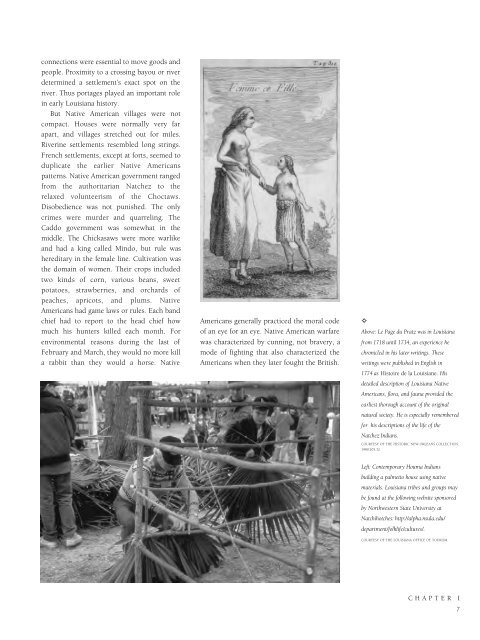Historic Louisiana
An illustrated history of Louisiana, paired with the histories of companies, families and organizations that make the state great.
An illustrated history of Louisiana, paired with the histories of companies, families and organizations that make the state great.
You also want an ePaper? Increase the reach of your titles
YUMPU automatically turns print PDFs into web optimized ePapers that Google loves.
connections were essential to move goods and<br />
people. Proximity to a crossing bayou or river<br />
determined a settlement’s exact spot on the<br />
river. Thus portages played an important role<br />
in early <strong>Louisiana</strong> history.<br />
But Native American villages were not<br />
compact. Houses were normally very far<br />
apart, and villages stretched out for miles.<br />
Riverine settlements resembled long strings.<br />
French settlements, except at forts, seemed to<br />
duplicate the earlier Native Americans<br />
patterns. Native American government ranged<br />
from the authoritarian Natchez to the<br />
relaxed volunteerism of the Choctaws.<br />
Disobedience was not punished. The only<br />
crimes were murder and quarreling. The<br />
Caddo government was somewhat in the<br />
middle. The Chickasaws were more warlike<br />
and had a king called Mindo, but rule was<br />
hereditary in the female line. Cultivation was<br />
the domain of women. Their crops included<br />
two kinds of corn, various beans, sweet<br />
potatoes, strawberries, and orchards of<br />
peaches, apricots, and plums. Native<br />
Americans had game laws or rules. Each band<br />
chief had to report to the head chief how<br />
much his hunters killed each month. For<br />
environmental reasons during the last of<br />
February and March, they would no more kill<br />
a rabbit than they would a horse. Native<br />
Americans generally practiced the moral code<br />
of an eye for an eye. Native American warfare<br />
was characterized by cunning, not bravery, a<br />
mode of fighting that also characterized the<br />
Americans when they later fought the British.<br />
✧<br />
Above: Le Page du Pratz was in <strong>Louisiana</strong><br />
from 1718 until 1734, an experience he<br />
chronicled in his later writings. These<br />
writings were published in English in<br />
1774 as Histoire de la Louisiane. His<br />
detailed description of <strong>Louisiana</strong> Native<br />
Americans, flora, and fauna provided the<br />
earliest thorough account of the original<br />
natural society. He is especially remembered<br />
for his descriptions of the life of the<br />
Natchez Indians.<br />
COURTESY OF THE HISTORIC NEW ORLEANS COLLECTION,<br />
1980.205.32.<br />
Left: Contemporary Houma Indians<br />
building a palmetto house using native<br />
materials. <strong>Louisiana</strong> tribes and groups may<br />
be found at the following website sponsored<br />
by Northwestern State University at<br />
Natchihotches: http://alpha.nsula.edu/<br />
department/folklife/cultures/.<br />
COURTESY OF THE LOUISIANA OFFICE OF TOURISM.<br />
CHAPTER I<br />
7
















